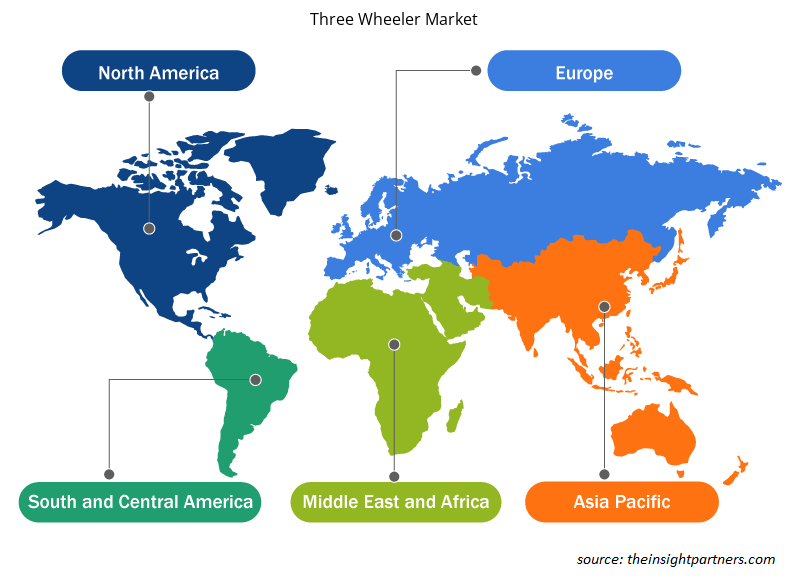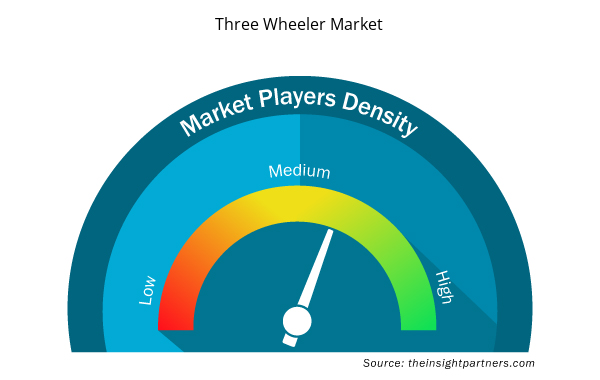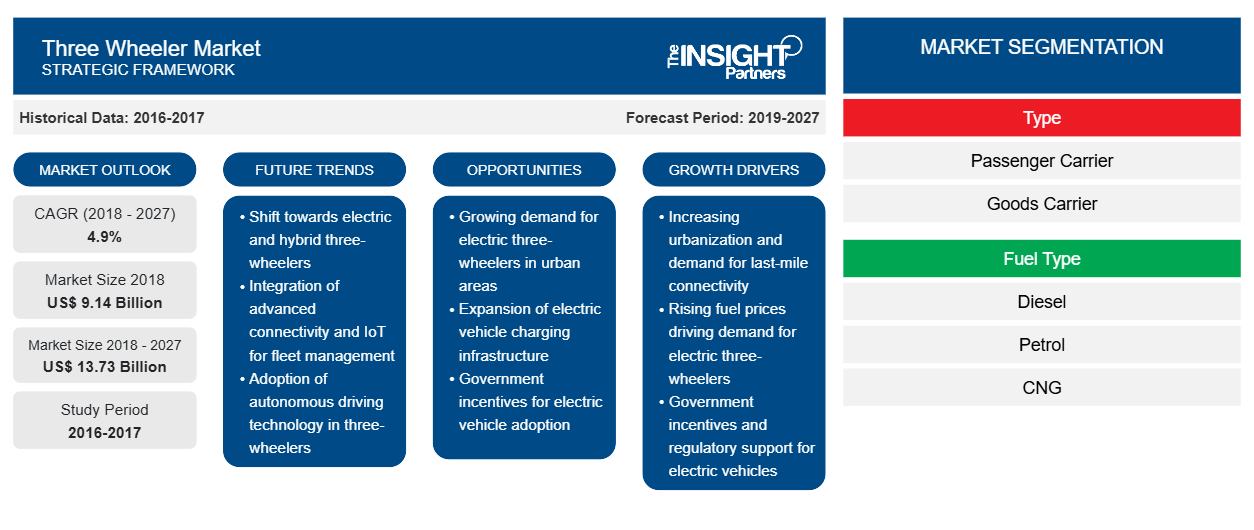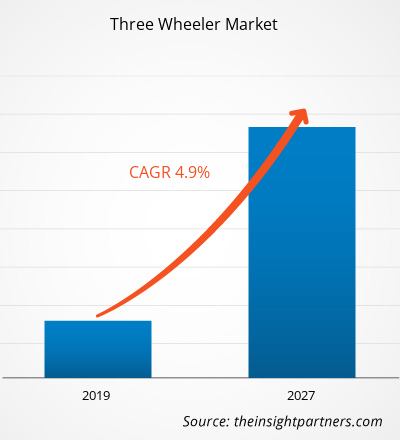2018 年三轮车市场价值为 91.4 亿美元,预计 2019 年至 2027 年的复合年增长率为 4.9%,到 2027 年达到 137.3 亿美元。
三轮客运车是用于运输乘客的三轮车。三轮客运车至少可载三名乘客,最多可载五至六名乘客。在农村地区,根据需要,六名以上的乘客可乘坐三轮客运车。电动三轮车是三轮车的主要类型之一。电动三轮车采用电池驱动,是一种环保车辆,与传统三轮车相比,产生的车辆排放更少,噪音更小。电动三轮车可搭载五至六名乘客进行运输。电动三轮车需求的增加、人口的增加以及对有助于缓解交通拥堵的车辆的需求的增加,推动了全球三轮车市场的增长。2018 年,亚太地区在预测期内在三轮车市场中占据突出地位 。预计印度等国家将在预测期内主导国内和出口业务领域。此外,印度许多老牌企业正专注于生产符合 BS (Bharat Stage) VI 标准的三轮车,该标准将于 2020 年实施,以控制颗粒物、氮氧化物和硫的排放。由于印度农村和半城市地区对交通工具的需求不断增加以及人口不断增长,中国、泰国和马来西亚等其他亚洲国家都出现了显著增长。
定制此报告以满足您的需求
您可以免费定制任何报告,包括本报告的部分内容、国家级分析、Excel 数据包,以及为初创企业和大学提供优惠和折扣
- 获取此报告的关键市场趋势。这个免费样品将包括数据分析,从市场趋势到估计和预测。
市场洞察
对环保三轮车的需求不断增长,推动了市场的增长
全球汽车行业正经历着新三轮车制造商数量的不断增加。三轮车制造商不断关注电动三轮车领域的发展,因为该领域正在吸引全球客户的兴趣。全球汽车行业正在经历从传统三轮车到电动三轮车的重大转变。
各国政府都在积极推广电动三轮车。例如,2018 年 3 月,印度重工业和公共企业部启动了 FAME 印度计划第二阶段,该计划于 2019 年 4 月 1 日启动,为期三年,总预算支持金额为 13.9 亿美元。此阶段主要支持公共和共享交通电气化,旨在通过补贴支持 7000 辆电动公交车、50 万辆电动三轮车、55000 辆电动四轮乘用车和 100 万辆电动两轮车。FAME 计划的这一阶段希望建立足够的公共充电基础设施,以增强电动汽车用户的信心。为此,重工业和公共企业部期待各利益相关方的参与和积极参与,包括工业和公共部门企业 (PSE) 以及政府机构。市场的主要参与者都致力于开发电动汽车。例如,意大利汽车制造商比亚乔公司 (Piaggio & C. SpA) 在其比亚乔 Ape Electrik 电动三轮车系列中推出了比亚乔 Ape E-City。E-auto 配备可更换锂离子电池,一次充电可行驶约 70-80 公里。此外,2019 年 8 月,Euler Motors 宣布将于 2020 年初在印度推出电动三轮轻型商用货车。
从地理位置上看,印度和中国拥有众多三轮车制造商,电动三轮车的接受度也逐年飙升。除印度和中国外,巴西、阿根廷等南美国家,以及南非、尼日利亚、埃及等中东和非洲国家在汽车行业采用电动三轮车方面也发展迅速。亚太地区在汽车行业占据主导地位,并正在经历巨大的增长。尽管如此,在该地区运营的汽车公司需要与零部件供应商建立更多合作伙伴关系,以便在电动三轮车部署方面呈指数级增长。与其他市场参与者的战略伙伴关系、协作、合同和收购是行业参与者推动其市场的主要因素,预计这将在未来几年推动全球三轮车市场的发展。
类型洞察
在类型细分市场中,客运车在全球三轮车市场中占据最大份额。客运车是各种私人运输运营商和以运输工作为收入来源的个人能够负担得起的最便宜的运输工具。该细分市场的增长是由对低成本客运车的需求不断增长推动的,例如缺乏适当的道路,三轮车主要是由于交通设施不足以及交通拥堵严重的城市地区。
燃料类型洞察
根据燃料类型,三轮车市场分为柴油、汽油、压缩天然气、液化石油气和电动。汽油车在全球三轮车市场占据主导地位。
市场举措是公司为扩大其全球影响力并满足不断增长的客户需求而采取的一种策略。三轮车市场的市场参与者主要专注于通过集成先进的功能和技术来增强产品和服务。通过签署合作伙伴关系、合同、合资企业和在世界各地开设新办事处,公司正试图提高其市场份额和品牌知名度。大多数市场举措都出现在亚太地区,该地区未来市场增长潜力巨大。下面列出了其中一些举措;
2019 年:2019 年 12 月,Greaves Cotton 宣布与 TVS Motor Company 建立合作伙伴关系。根据这一合作关系,Greaves Cotton 将成为 TVS Motor 在印度的三轮车授权服务中心。2018
年:ATUL Auto Limited 与总部位于印度的汽车零部件公司 JBM Industries 合作。该公司已合作扩大其三轮电动车业务。
三轮车市场区域洞察
Insight Partners 的分析师已详细解释了预测期内影响三轮车市场的区域趋势和因素。本节还讨论了北美、欧洲、亚太地区、中东和非洲以及南美和中美洲的三轮车市场细分和地理位置。

- 获取三轮车市场的区域特定数据
三轮车市场报告范围
| 报告属性 | 细节 |
|---|---|
| 2018 年市场规模 | 91.4亿美元 |
| 2027 年市场规模 | 137.3亿美元 |
| 全球复合年增长率(2018 - 2027) | 4.9% |
| 史料 | 2016-2017 |
| 预测期 | 2019-2027 |
| 涵盖的领域 | 按类型
|
| 覆盖地区和国家 | 北美
|
| 市场领导者和主要公司简介 |
|
市场参与者密度:了解其对商业动态的影响
由于消费者偏好的不断变化、技术进步以及对产品优势的认识不断提高等因素,终端用户需求不断增加,推动了三轮车市场快速增长。随着需求的增加,企业正在扩大其产品范围,进行创新以满足消费者需求,并利用新兴趋势,从而进一步推动市场增长。
市场参与者密度是指在特定市场或行业内运营的企业或公司的分布情况。它表明在给定市场空间中,相对于其规模或总市场价值,有多少竞争对手(市场参与者)存在。
在三轮车市场运营的主要公司有:
- ATUL汽车有限公司
- 比亚乔公司
- 巴贾杰汽车有限公司
- JS 汽车 (P) 有限公司
- Speego 车辆有限公司
免责声明:上面列出的公司没有按照任何特定顺序排列。

- 获取三轮车市场顶级关键参与者概览
三轮车市场 – 按类型
- 客运公司
- 货物承运人
三轮车市场 – 按燃料类型
- 柴油机
- 汽油
- 天然气
- 液化石油气
- 电的
全球三轮车市场(按区域)
北美
- 我们
- 加拿大
- 墨西哥
欧洲
- 法国
- 德国
- 意大利
- 英国
- 俄罗斯
- 欧洲其他地区
亚太地区
- 中国
- 印度
- 韩国
- 日本
- 澳大利亚
- 亚太其他地区
世界其他地区
- 非洲
- 拉美
公司简介
- ATUL汽车有限公司
- 巴贾杰汽车有限公司
- JS 汽车 (P) 有限公司
- 马恒达有限公司
- 比亚乔公司
- 印度踏板车有限公司
- Speego 车辆有限公司
- Terra 汽车公司
- TVS 汽车公司
- 香河强盛电动三轮车厂
- 历史分析(2 年)、基准年、预测(7 年)及复合年增长率
- PEST 和 SWOT 分析
- 市场规模价值/数量 - 全球、区域、国家
- 行业和竞争格局
- Excel 数据集


- Emergency Department Information System (EDIS) Market
- Cling Films Market
- Smart Water Metering Market
- Parking Management Market
- Bathroom Vanities Market
- Fertilizer Additives Market
- Sandwich Panel Market
- Data Annotation Tools Market
- Social Employee Recognition System Market
- Advanced Planning and Scheduling Software Market

Report Coverage
Revenue forecast, Company Analysis, Industry landscape, Growth factors, and Trends

Segment Covered
This text is related
to segments covered.

Regional Scope
North America, Europe, Asia Pacific, Middle East & Africa, South & Central America

Country Scope
This text is related
to country scope.
常见问题
The three-wheeler passenger carrier segment dominates the global three-wheeler market as it is one of the cheapest transport vehicles that can be afforded by various private transport operators and by individuals whose earning is from transport jobs. Asian countries like Bangladesh, Sri Lanka, and Nepal and African countries like Ghana, Nigeria, Tanzania, and Kenya accounted for more than 90% of the exports in the Indian three-wheeler PC market. During 2018, the ICE-powered three-wheelers segment accounted for the significant shares and dominated the three-wheel passenger carrier market due to the increased usage of diesel, gasoline, bio-diesel, and compressed natural gas/liquefied petroleum gas (CNG/LPG) to power the engine in developing nations. In Asia-Pacific, India is the major contributor to the three-wheeler passenger carrier market
The key players in the market are focusing on investing in the production of three wheelers in African and South American countries. There have been prominent strategies made in recent years by automakers to increase the usage of three wheelers in these regions. For instance, in August 2016, Lohia Auto Industries entered Africa with three wheeler operated on diesel. A reduction in organized public transport systems has led to rapid growth in non-conventional means of public transport, initially provided by minibuses and shared taxi/vans, and more recently by commercial three-wheelers. Unlike cities in South and East Asia, ownership and use of motorized and electric three-wheelers as a personalized vehicle is extremely small in sub-Saharan cities
The massive populations of China and India and the mounting middle-class population in these countries, as well as booming automotive sector scenarios in both countries, are anticipated to have a bright future for the adoption of three-wheeler vehicles. These countries are the hub for various local automakers, which are focusing on the development of a three-wheeler vehicle, most commonly known as auto-rickshaw/ tuk-tuk. Furthermore, China is the largest producer of passenger cars across the globe; also, India, Japan, and South Korea are some of the primary vehicle manufacturing countries. The continuous economic growth in developed and developing countries such as India and China, coupled with the presence of a high number of manufacturers in countries such as China and Japan, has facilitated the rapid growth of the automotive industry in this region
Trends and growth analysis reports related to Automotive and Transportation : READ MORE..
The List of Companies - Three Wheeler Market
- ATUL Auto Limited
- Piaggio & C. SpA
- Bajaj Auto Ltd
- J.S. AUTO (P) LTD.
- Speego Vehicles Co Pvt Limited
- Mahindra & Mahindra Ltd.
- Scooters India Limited
- TVS Motor Company
- Terra Motors Corporation
- Xianghe Qiangsheng Electric Tricycle Factory
The Insight Partners performs research in 4 major stages: Data Collection & Secondary Research, Primary Research, Data Analysis and Data Triangulation & Final Review.
- Data Collection and Secondary Research:
As a market research and consulting firm operating from a decade, we have published and advised several client across the globe. First step for any study will start with an assessment of currently available data and insights from existing reports. Further, historical and current market information is collected from Investor Presentations, Annual Reports, SEC Filings, etc., and other information related to company’s performance and market positioning are gathered from Paid Databases (Factiva, Hoovers, and Reuters) and various other publications available in public domain.
Several associations trade associates, technical forums, institutes, societies and organization are accessed to gain technical as well as market related insights through their publications such as research papers, blogs and press releases related to the studies are referred to get cues about the market. Further, white papers, journals, magazines, and other news articles published in last 3 years are scrutinized and analyzed to understand the current market trends.
- Primary Research:
The primarily interview analysis comprise of data obtained from industry participants interview and answers to survey questions gathered by in-house primary team.
For primary research, interviews are conducted with industry experts/CEOs/Marketing Managers/VPs/Subject Matter Experts from both demand and supply side to get a 360-degree view of the market. The primary team conducts several interviews based on the complexity of the markets to understand the various market trends and dynamics which makes research more credible and precise.
A typical research interview fulfils the following functions:
- Provides first-hand information on the market size, market trends, growth trends, competitive landscape, and outlook
- Validates and strengthens in-house secondary research findings
- Develops the analysis team’s expertise and market understanding
Primary research involves email interactions and telephone interviews for each market, category, segment, and sub-segment across geographies. The participants who typically take part in such a process include, but are not limited to:
- Industry participants: VPs, business development managers, market intelligence managers and national sales managers
- Outside experts: Valuation experts, research analysts and key opinion leaders specializing in the electronics and semiconductor industry.
Below is the breakup of our primary respondents by company, designation, and region:

Once we receive the confirmation from primary research sources or primary respondents, we finalize the base year market estimation and forecast the data as per the macroeconomic and microeconomic factors assessed during data collection.
- Data Analysis:
Once data is validated through both secondary as well as primary respondents, we finalize the market estimations by hypothesis formulation and factor analysis at regional and country level.
- Macro-Economic Factor Analysis:
We analyse macroeconomic indicators such the gross domestic product (GDP), increase in the demand for goods and services across industries, technological advancement, regional economic growth, governmental policies, the influence of COVID-19, PEST analysis, and other aspects. This analysis aids in setting benchmarks for various nations/regions and approximating market splits. Additionally, the general trend of the aforementioned components aid in determining the market's development possibilities.
- Country Level Data:
Various factors that are especially aligned to the country are taken into account to determine the market size for a certain area and country, including the presence of vendors, such as headquarters and offices, the country's GDP, demand patterns, and industry growth. To comprehend the market dynamics for the nation, a number of growth variables, inhibitors, application areas, and current market trends are researched. The aforementioned elements aid in determining the country's overall market's growth potential.
- Company Profile:
The “Table of Contents” is formulated by listing and analyzing more than 25 - 30 companies operating in the market ecosystem across geographies. However, we profile only 10 companies as a standard practice in our syndicate reports. These 10 companies comprise leading, emerging, and regional players. Nonetheless, our analysis is not restricted to the 10 listed companies, we also analyze other companies present in the market to develop a holistic view and understand the prevailing trends. The “Company Profiles” section in the report covers key facts, business description, products & services, financial information, SWOT analysis, and key developments. The financial information presented is extracted from the annual reports and official documents of the publicly listed companies. Upon collecting the information for the sections of respective companies, we verify them via various primary sources and then compile the data in respective company profiles. The company level information helps us in deriving the base number as well as in forecasting the market size.
- Developing Base Number:
Aggregation of sales statistics (2020-2022) and macro-economic factor, and other secondary and primary research insights are utilized to arrive at base number and related market shares for 2022. The data gaps are identified in this step and relevant market data is analyzed, collected from paid primary interviews or databases. On finalizing the base year market size, forecasts are developed on the basis of macro-economic, industry and market growth factors and company level analysis.
- Data Triangulation and Final Review:
The market findings and base year market size calculations are validated from supply as well as demand side. Demand side validations are based on macro-economic factor analysis and benchmarks for respective regions and countries. In case of supply side validations, revenues of major companies are estimated (in case not available) based on industry benchmark, approximate number of employees, product portfolio, and primary interviews revenues are gathered. Further revenue from target product/service segment is assessed to avoid overshooting of market statistics. In case of heavy deviations between supply and demand side values, all thes steps are repeated to achieve synchronization.
We follow an iterative model, wherein we share our research findings with Subject Matter Experts (SME’s) and Key Opinion Leaders (KOLs) until consensus view of the market is not formulated – this model negates any drastic deviation in the opinions of experts. Only validated and universally acceptable research findings are quoted in our reports.
We have important check points that we use to validate our research findings – which we call – data triangulation, where we validate the information, we generate from secondary sources with primary interviews and then we re-validate with our internal data bases and Subject matter experts. This comprehensive model enables us to deliver high quality, reliable data in shortest possible time.


 获取此报告的免费样本
获取此报告的免费样本